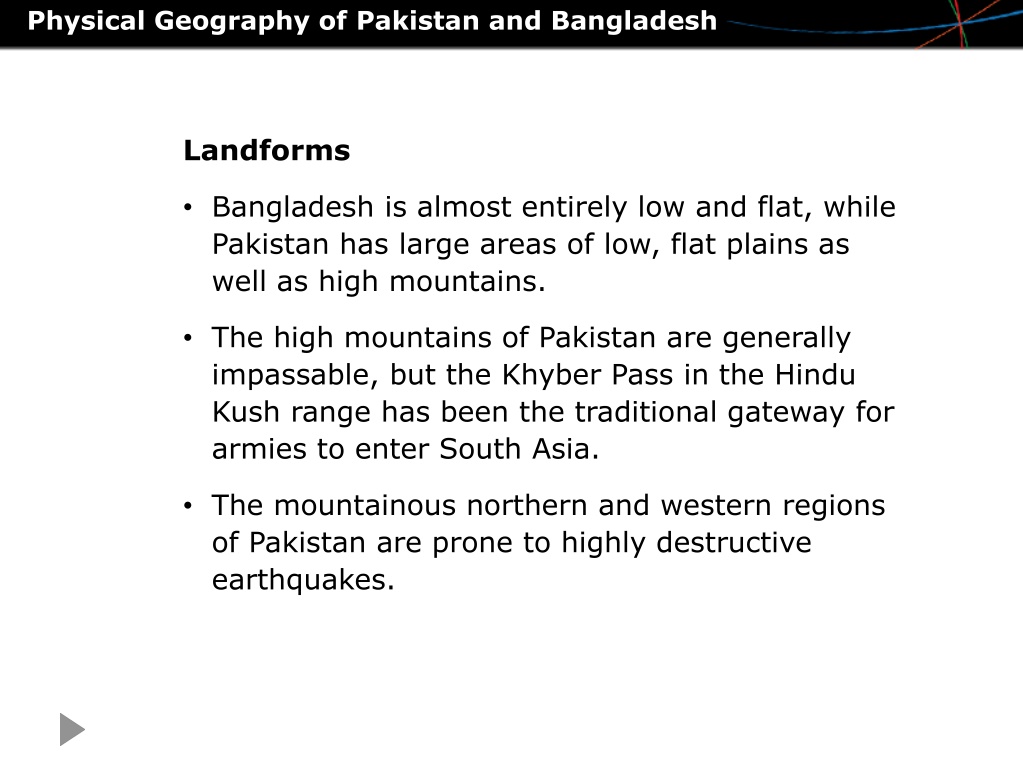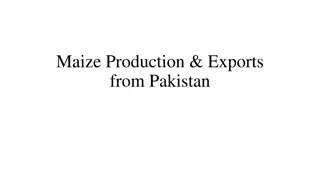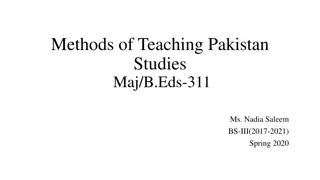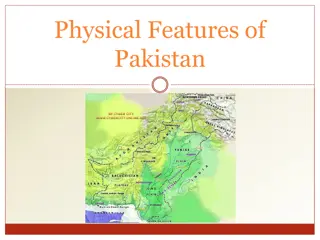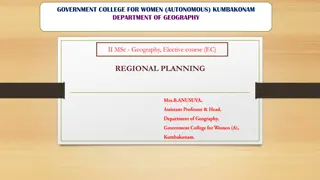Geography and Society of Pakistan and Bangladesh
Physical geography of Pakistan features low plains and high mountains, while Bangladesh is predominantly flat. The water systems in both countries play a crucial role, with rivers like the Ganges providing water resources. The climates vary between the tropical wet climate of Bangladesh and the dry climate of Pakistan. Both countries have unique population patterns, high population densities, and significant cultural influences.
Download Presentation

Please find below an Image/Link to download the presentation.
The content on the website is provided AS IS for your information and personal use only. It may not be sold, licensed, or shared on other websites without obtaining consent from the author. Download presentation by click this link. If you encounter any issues during the download, it is possible that the publisher has removed the file from their server.
E N D
Presentation Transcript
Physical Geography of Pakistan and Bangladesh Landforms Bangladesh is almost entirely low and flat, while Pakistan has large areas of low, flat plains as well as high mountains. The high mountains of Pakistan are generally impassable, but the Khyber Pass in the Hindu Kush range has been the traditional gateway for armies to enter South Asia. The mountainous northern and western regions of Pakistan are prone to highly destructive earthquakes.
Physical Geography of Pakistan and Bangladesh Water Systems The most important river in South Asia, the Ganges, draws water from a 400,000-square- mile basin and provides an important source of hydroelectric power, as do the Indus and the Brahmaputra Rivers. Depressions in Bangladesh form freshwater wetlands that maintain fish life and provide support for agriculture. Coastal regions in both countries are prone to flooding from monsoons, cyclones, and tsunamis.
Physical Geography of Pakistan and Bangladesh Climates, Biomes, and Resources Seasonal monsoons create three distinct seasons: hot, hot and wet, and cool. The tropical wet climate of Bangladesh is home to rare and endangered fish, birds, and plant species. Pakistan has a much drier climate than Bangladesh and has far less vegetation. Rivers provide for basic human and economic needs. Both countries have few natural resources.
Human Geography of Pakistan and Bangladesh History and Government Pakistan and Bangladesh share a similar history of Muslim influence, British colonialism, and the pursuit of independence. Independence in Pakistan has been marked by instability, violence, and continuous struggle with India over the Kashmir region. Ethnically different from Pakistan, the Bengali people of Bangladesh gained independence with help from India, although rivalries have made stable rule difficult.
Human Geography of Pakistan and Bangladesh Population Patterns Both countries have high populations, a third of whom are under the age of 15. Most Pakistanis live in rural areas along the Indus River, though more people are migrating to cities. Bangladesh is the most densely populated country in South Asia, but the total fertility rate, or average number of children a women has in her lifetime, is dropping. Pakistan s population continues to rapidly expand at an annual growth rate of two percent.
Human Geography of Pakistan and Bangladesh Society and Culture Today Islam is the predominant religion in both countries. Literacy rates in both countries are very low, with the male rates exceeding the female rates. Extended families often live in the same home, and marriages are often arranged, with the wife going to live with her husband s family. Literature and dance are important in Bangladesh, just as music and literature take precedence in Pakistan.
Human Geography of Pakistan and Bangladesh Economic Activities Poverty in both nations is widespread. Both rely on agriculture and textiles, although the service sector is growing in Pakistan. In Pakistan, the railway is the primary mode of transport. Most Bangladeshis are sharecroppers, and rice is the major crop. Bangladesh is also a leading producer in the field of aquaculture.
People and Their Environment: Pakistan and Bangladesh Managing Resources As a result of their heavily agricultural economies, most live in poverty. Sustainable development, or economic growth that meets the population s needs without hampering the ability of future populations to do the same, was introduced to reduce the gap between the wealthy and poor. Incorporating this philosophy has been difficult, as both countries have made short-term choices that cause long-term negative consequences.
People and Their Environment: Pakistan and Bangladesh Human Impact Polluted air and water, soil erosion, and deforestation are all negative human impacts in the subregion. Raw sewage, industrial pollution, and agricultural runoff plagues both countries water supplies. Indoor air pollution also threatens populations, as people burn wood and animal dung for fuel. Deforestation has enabled heavy flooding to become even more devastating to the area.
People and Their Environment: Pakistan and Bangladesh Addressing the Issues Although both countries are making efforts to improve, those efforts have been inconsistent and only marginally successful. Pakistan has promoted compressed natural gas (CHG) vehicles to reduce air pollution, but the lack of fueling stations hampers efforts to expand sales. Climate change puts low-lying Bangladesh at great risk if more severe and prolonged storms occur, although the nation produces low amounts of the greenhouse gases that contribute to the problem.
